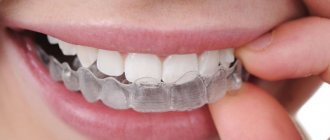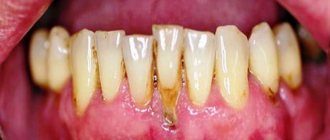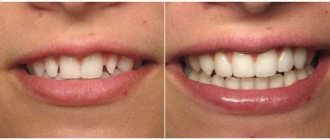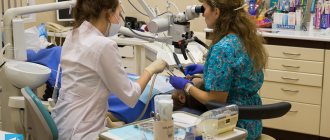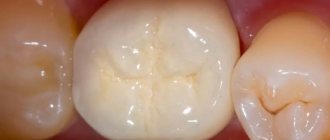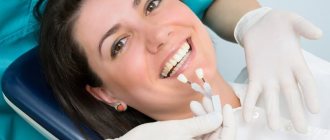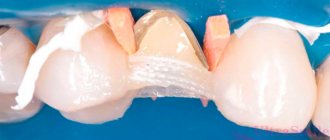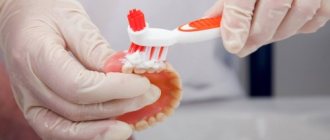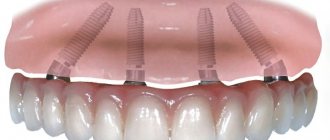Many patients of orthopedic dentists after prosthetics talk about how difficult it was for them to get used to dentures. High-quality permanent artificial teeth and crowns are compact in size and do not cause any discomfort. But with removable ones, problems arise: from unpleasant sensations in the palate and irritating pressure on the gums to constant nausea and even a gag reflex. Each patient experiences the adaptation process in his own way, so it can last only a couple of days, one or two weeks, or several months.
Why does discomfort occur?
A person with missing teeth gets used to living without them. His dental system begins to distribute the chewing load differently, and the muscles, cheeks, nerves, tongue and jaw bones involved in the process gradually get used to the restructuring that has occurred.
If missing teeth can be restored with permanent dentures, the parameters of which are almost identical to natural teeth, the load when chewing food turns out to be natural. And the absence of foreign elements - fixing hooks and staples - guarantees the absence of irritation of the mucous membranes of the cheeks and tongue.
In removable structures, the chewing load is distributed differently. For example, popular clasp dentures distribute it to the palate and the remaining adjacent teeth. It is clear that the sensations when chewing food will be unusual at first and will almost certainly cause irritation.
Oral hygiene with removable prosthetics
At first, after installing the prosthesis, discomfort may occur. The gums need to adapt to the design. Typical problems in the first few days of using a new denture: impaired diction, pain and redness of the gums associated with rubbing. If you immediately begin to properly care for your gums and structures, these symptoms will go away.
Basic Rules:
- Wash your denture after every meal. Goal: remove food debris, prevent plaque formation and microbial attack. It is enough to rinse the structure with running water. If you use gels or other means for fixation, there is no need to remove the denture: just rinse your mouth thoroughly with clean water or a special rinse, for example, ASEPTA® Active.
- Clean the prosthesis once a day. It must be cleaned daily with a toothbrush and a special paste (you can use children's paste) with minimal abrasiveness. Under no circumstances should you use tooth powder or whitening pastes containing solid particles. Aggressive components scratch the surface of artificial teeth, as a result they become dirty faster and the service life of the prosthesis is reduced. You should choose a brush with soft bristles.
- Using special products for the prosthesis once a week. The most popular: effervescent tablets and ultrasound baths. The tablets quickly dissolve in water and contain special antiseptics and enzymes (substances that accelerate the action of antiseptics): just dip the prosthesis into the solution and after a few hours it will be completely cleared of bacterial plaque and, as a result, unpleasant odor. Ultrasonic baths help even faster than effervescent tablets: they easily destroy plaque even in hard-to-reach places.
- Professional cleaning once every six months. Done at the dentist.
It is important not only to wash and clean the structure, but also to store it properly at night. To do this, use plain water or special pharmaceutical solutions. When stored in a dry environment, the denture may become deformed, so it is important to soak it completely. The optimal liquid temperature is room temperature.
Important! Be sure to take proper care of the remaining teeth in your mouth. To do this, we use a separate brush with bristles selected according to the condition of the teeth (usually medium hardness) and a suitable toothpaste.
To fix dentures, doctors recommend using special powders, creams and gels. Firstly, they securely fasten the structure to the gums, and secondly, they prevent food particles from getting under the denture.
What inconveniences can you encounter after prosthetics?
Dentists installing dentures in Moscow warn in advance about possible discomfort that may manifest itself:
- noticeably irritating sensation of a foreign body in the oral cavity;
- pain caused by the pressure of the structure on the supporting teeth and especially the gums;
- rubbing of mucous membranes, redness and swelling, formation of bedsores on the gums;
- a feeling of poor closure of the jaws and teeth;
- increased salivation caused by the perception of the prosthesis as food that needs to be easier to move from the mouth to the throat;
- the appearance of gagging as a reaction to the presence of a foreign body in the mouth;
- impaired diction, which can be caused by even the best removable dentures (the tongue needs time to get used to changing position when pronouncing sounds);
- partial loss of taste of products caused by the closure of certain areas of the oral mucosa by the prosthesis.
In what cases is pain in a pulpless tooth dangerous?
DentoSpas Clinic recommends contacting your doctor again if the following symptoms appear:
- the pain becomes sharp, throbbing, intensifies, does not weaken, and may be more pronounced at night;
- painkillers prescribed by the doctor do not work or relieve pain only slightly;
- there is sensitivity, discomfort when contacting cold;
- the patient has a fever and other symptoms of illness: weakness, headache;
- the gums become very swollen and inflamed;
- discomfort persists for a long time or returns some time after treatment (the tooth begins to hurt again).
These signs indicate complications of endodontic treatment. Pain may have several causes.
Reappearance of infection. Occurs if the infected tissue was not completely removed during the initial treatment. A source of infection remained inside the crown, under the filling, and tissue destruction continued.
Errors during filling. If the root canals are not filled tightly or completely, the voids remaining inside them threaten the re-development of infection. Microbes penetrate into them through surrounding tissues, causing inflammation. The pain comes from him. Another possible mistake is that the canals are not filled with filling material to the full depth. To exclude it, the DentoSpas clinic performs control radiography and uses an apex locator to assess the depth of the canals. There should be no voids left at the root apex after filling - this is dangerous due to the formation of granulomas and cysts, and destruction of hard tissues.
The filling material has gone beyond the root tip. This occurs if it is squeezed out through the apical foramen. Dental cement in this case hardens in the periodontal tissues, squeezing the nerves and impairing blood circulation. Because of this, inflammation begins and severe pain appears.
Perforation of the root walls. When cleaning root canals, the root walls may be perforated with an endodontic instrument. At the site of the hole, the tissue becomes infected and inflamed. When filling, perforation is dangerous due to the filling material leaving the root canal.
A fragment of the instrument remains inside the channel. This is a rare mistake. Such debris is clearly visible on control X-ray photographs. If they still remain inside the canal, it becomes clogged, making it more difficult to treat. Because of this, infected tissue remains at the root tip, which provokes re-inflammation.
Complications can arise not only due to treatment errors:
- allergy. Individual sensitivity to the components of the filling material or the medications used, their intolerance can provoke the appearance of pain, swelling, and discomfort immediately after treatment. Such symptoms do not go away on their own, they gradually intensify, and severe inflammation begins;
- damage to the adjacent tooth. The pain in it can spread along the gums and radiate into the pulpless tooth;
- trigeminal nerve injury. It occurs if it passes next to a pulpless tooth and was touched during its treatment. In this case, the pain is shooting, may be accompanied by numbness, and spread throughout the jaw.
Do you really have to put up with this?
Making dentures is quite a complex job, in some ways even comparable to art. Working in tandem, the orthopedic surgeon and the dental technician put a lot of effort into making an accurate and as comfortable prosthesis as possible. But in most cases, after putting it on and wearing it, it turns out that it needs some adjustment to the patient’s gums.
To regain lost comfort, you need to walk with the installed structure for 3–4 weeks. During this time, you can get used to the initially interfering prosthesis and get rid of the unpleasant sensations. If you simply remove it when discomfort appears, then you will have to describe all the inconveniences experienced in words, and the doctor will not be able to understand what exactly caused them. Do you want the correction to be effective? Be sure to come to your appointment wearing a prosthesis that causes discomfort.
Correction of dentures is carried out within 15–20 minutes. As a rule, it is possible to restore the patient’s comfort in one or two visits to the dental clinic.
Why do my teeth hurt and my gums hurt after grinding my teeth for a crown?
Hello Svetlana! Yes, you have a lot of questions, let’s look at them in order. In general, in a good way, your teeth shouldn’t hurt after grinding. And your gums shouldn't hurt. It happens that when work is carried out on living teeth, there may be a slightly increased sensitivity to thermal stimuli - cold, hot water. At this moment, despite the fact that there are temporary crowns, the patient still needs to observe a little temperature control in food. Not very hot, but not very cold either. If the winter season is cold, then it is advisable not to breathe through your mouth so as not to get pulpitis, because the tooth is a little, so to speak, “stripped”, it lacks a small layer of enamel. At such a moment, he, of course, can react to cold air. Another cause of discomfort after tooth preparation - grinding - can be a reaction from the gums to the retraction thread, because the retraction thread is laid along the neck of the tooth, and this is most often done with the use of anesthesia so that the entire manipulation is comfortable and painless. But then, during this day, there may be slight discomfort and even slight pain in the area of the ground teeth that were subjected to this procedure. But such pain should have a short-term effect.
Of course, all this will go away on its own, but if you don’t want to endure it, you can take some painkiller that usually helps, which you already know. Of the well-known ones, we can recommend Nurofen or the drug Ketanov. But here it is better to consult with your doctor.
There is no point in enduring pain for a long time, because if there is pain and if it is such that you really have to endure it when a person “climbs the wall,” then of course this is a reason to contact the doctor and tell him about this situation. And my next answer to the question is important, and I ask you to pay special attention to it.
What consequences can the situation lead to if the cause of the pain is not removed?
If the cause of the pain is not eliminated, the situation can lead to pulpitis, that is, inflammation of the nerve.
And depending on what your pain sensitivity threshold is, some are able to endure it or endure it on painkillers. But when the pulp, that is, the nerve in common parlance, dies, the decay products go into the bone tissue and the situation turns into another disease called periodontitis, that is, inflammation of the tissues surrounding the tooth. From the point of view of tooth preservation, this is already a risky event, that is, such a tooth can be lost later if not treated. But, I hope, you only have a slight malaise, which should go away within the first 24 hours.
Clinical researches
All ASEPTA products are clinically proven effective.
- Repeated clinical studies have proven that the two-component mouth rinse ASEPTA ACTIVE more effectively combats the causes of inflammation and bleeding compared to single-component rinses - it reduces inflammation by 41% and reduces bleeding gums by 43%.
- It has also been clinically proven that regular use of preventive toothpaste ASEPTA ACTIVE for a month can reduce bleeding gums by 60%, improve overall oral health by 44% and reduce inflammation by 33%.
- Laboratory studies have proven that using ASEPTA adhesive gum balm for a week can reduce gum bleeding by 51% and reduce inflammation by 50%.
Sources:
- The role of anti-inflammatory rinse in the treatment of periodontal diseases (L.Yu. Orekhova, A.A. Leontyev, S.B. Ulitovsky) L.Yu. OREKHOVA, Doctor of Medical Sciences, Prof., Head of Department; A.A. LEONTIEV, dentist; S.B. ULITOVSKY, Doctor of Medical Sciences, Prof. Department of Therapeutic Dentistry of St. Petersburg State Medical University named after. acad. I. P. Pavlova
- Clinical and laboratory assessment of the influence of domestic therapeutic and prophylactic toothpaste based on plant extracts on the condition of the oral cavity in patients with simple marginal gingivitis. Doctor of Medical Sciences, Professor Elovikova T.M.1, Candidate of Chemical Sciences, Associate Professor Ermishina E.Yu. 2, Doctor of Technical Sciences Associate Professor Belokonova N.A. 2 Department of Therapeutic Dentistry USMU1, Department of General Chemistry USMU2
- The use of adhesive balm "Asepta®" in the treatment of inflammatory periodontal diseases L.Yu. OREKHOVA*, Dr. med. Sciences, Professor, Head of Department V.V. CHPP**, Dr. med. Sciences, Professor, Head of Department S.B. ULITOVSKY*, Dr. med. Sciences, Professor A.A. LEONTIEV*, dentist A.A. DOMORAD**, O.M. YAKOVLEV** SPbSMU named after. acad. I.P. Pavlova, St. Petersburg - *Department of Therapeutic Dentistry, **Department of Microbiology
Why is the enamel grinding procedure carried out?
Grinding of teeth involves removing a layer of hard tissue (enamel and dentin), so that the orthopedic structure subsequently installed on the “support” looks natural and beautiful, fits tightly, is securely fixed, has stability and strength. This is also done to ensure that microbes do not get under the prosthesis or food debris gets clogged, which together can provoke the development of an inflammatory process.
On a note! Typically, the doctor removes a layer equal to the thickness of the chosen prosthesis. If a crown or bridge is installed, the tooth is ground down to a cone shape. When turning for microprostheses, for example, for veneers, the specialist “cuts down” the enamel in the frontal, lateral and cervical areas.
Often after the procedure, the patient’s gums around the ground tooth hurt, or the prepared element itself ache. Naturally, discomfort does not arise immediately, but after the anesthesia wears off. For some people, discomfort does not appear until several days, weeks or even months later. What is this connected with? We'll figure it out together.
Rules for dental care after removable dentures
Fixed prostheses include crowns, bridges, microprostheses (veneers, inlays), and implants. Ensuring their effective cleaning is more difficult than caring for removable structures: it’s easy to miss hard-to-reach places.
Dentists recommend following the following rules:
- Brush your teeth thoroughly 2 times a day. It is worth using a soft or medium-hard brush (preferably a hand brush), special pastes with low abrasiveness (for example: ASEPTA® Active therapeutic and prophylactic paste). If you use whitening pastes, avoid dentures when brushing.
- Use the irrigator after meals. It helps clean the interdental spaces from plaque, and is more effective with ASEPTA® solution. As a last resort, rinse your mouth thoroughly and use dental floss, including for cleaning dentures. Use floss carefully, especially in the crown area.
- Light gum massage. It is carried out to stimulate blood circulation and reduce the risk of gum inflammation.
Some manufacturers produce special brushes for cleaning teeth with dentures. Their bristles have different lengths, which allows you to effectively clean the interdental spaces.
What can't be used?
Many begin to experiment with a variety of remedies in an attempt to relieve pain. So what not to do:
- If the gums under the crown are inflamed, do not apply a heating pad. When heated, microorganisms multiply much faster and you may lose your tooth.
- Don't delay treatment. The longer you endure the pain, hoping that it will go away on its own, the more difficult it will be to cope with the developing disease.
You can order dental structures from a variety of materials, and the cost of metal-ceramic crowns is quite low. The main thing is to properly and promptly care for such products, monitor changes occurring in the oral cavity and promptly visit the dentist if your gums become inflamed.
